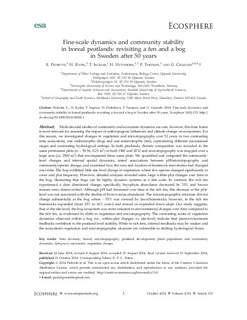| dc.description.abstract | Multi‐decadal studies of community and ecosystem dynamics are rare; however, this time frame is most relevant for assessing the impact of anthropogenic influences and climate change on ecosystems. For this reason, we investigated changes in vegetation and microtopography over 52 years in two contrasting mire ecosystems, one ombrotrophic (bog) and one minerotrophic (fen), representing different successional stages and contrasting hydrological settings. In both peatlands, floristic composition was recorded in the same permanent plots (n = 55‐56, 0.25 m2) in both 1960 and 2012 and microtopography was mapped over a large area (ca. 2500 m2) that encompassed these same plots. We quantified and compared the community‐level changes and internal spatial dynamics, tested associations between pH/microtopography and community/species change, and examined how the area and location of hummock microforms had changed over time. The bog exhibited little site level change in vegetation, where few species changed significantly in cover and plot frequency. However, detailed analyses revealed some large within‐plot changes over time in the bog, illustrating that bogs can be highly dynamic systems at a fine scale. In contrast, the rich fen experienced a clear directional change; specifically, bryophyte abundance decreased by 70% and brown mosses were almost extinct. Although pH had decreased over time at the rich fen, this decrease at the plot‐level was not associated with the decline of brown moss abundance. The microtopographic structure did not change substantially at the bog where ∼70% was covered by lawn/hummocks; however, in the rich fen hummocks expanded (from 10% to 16% cover) and moved or expanded down slope. Our study suggests, that at the site‐level, the bog ecosystem was more resistant to environmental changes over time compared to the rich fen, as evidenced by shifts in vegetation and microtopography. The contrasting scales of vegetation dynamics observed within a bog (i.e., within‐plot changes vs. site‐level) indicate that plant‐environment feedbacks contribute to the peatland level stability. While in rich fens, internal feedbacks may be weaker and the ecosystem's vegetation and microtopographic structure are vulnerable to shifting hydrological fluxes. | nb_NO |

